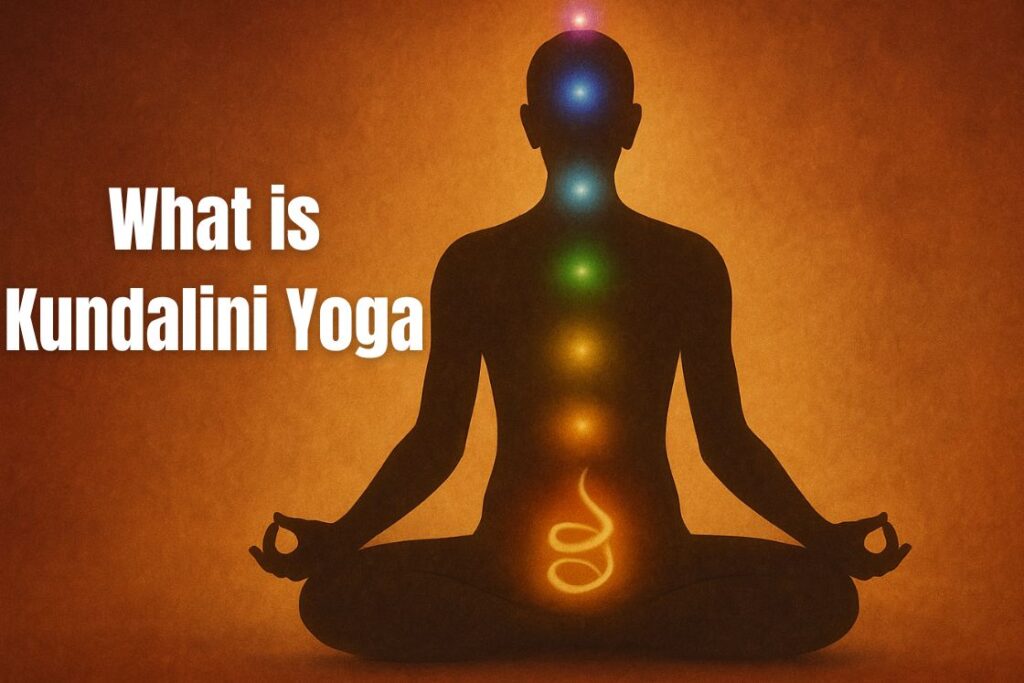
Kundalini Yoga works with the body, breath, mind, and subtle energy. It is a traditional path rooted in Tantra and classical yoga, designed to awaken inner clarity and deeper awareness.
Safety Note: Kundalini practices should be learned gradually and with guidance, especially if you are new to yoga or have health concerns.
Kundalini Yoga is a traditional yogic system that explores the hidden energy within the human body. Many yoga styles work mainly with posture, movement, or breath, but Kundalini Yoga goes further. It teaches that a quiet and powerful force rests at the base of the spine, and when prepared with the right practices, it supports growth in the body, mind, and awareness.
These teachings come from ancient yogic and Tantric traditions, where the human being is understood as a blend of physical structure, breath, subtle channels, and consciousness. The purpose of Kundalini Yoga is to bring these layers into balance so that the inner energy can move without obstruction.
For beginners, Kundalini may seem mysterious at first, but the idea is simple. Just as we have a nervous system and a circulatory system, yoga describes an inner system of energy channels and centers. Kundalini Yoga works with these through movement, breath, sound, and meditation.
What is kundalini? the primordial energy
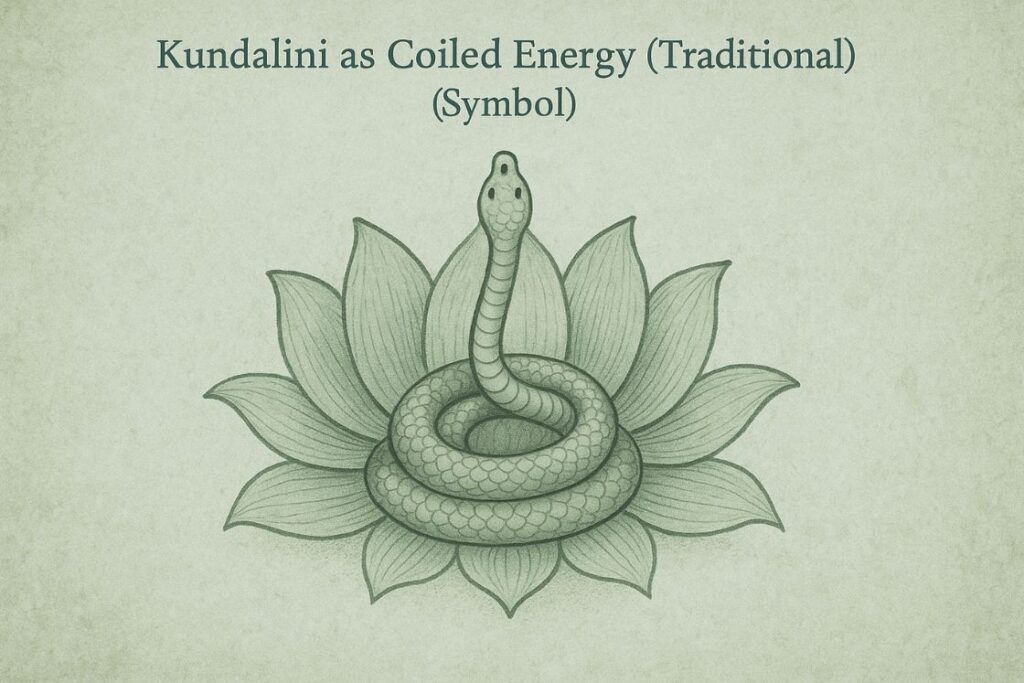
Kundalini is the inner coiled energy at the base of the spine described in classical yoga. It is seen as a hidden source of vitality, creativity, awareness, and spiritual growth. The word kundal means “coiled,” pointing to the idea that this energy rests in a folded and quiet state until the body and mind are ready.
According to yogic philosophy, two forces shape human experience:
- Purusha: pure consciousness
- Prakriti: creative energy
Kundalini is viewed as the expression of Prakriti inside each person. Many people cannot feel it clearly because it stays unmanifest, like a seed waiting for the right conditions to sprout. With steady breath, posture, mantra, and attention, this inner force becomes easier to sense.
The aim of Kundalini Yoga is not only to awaken this energy but to guide it gently and safely. When it begins to rise through the central channel of the spine, it touches the chakras, bringing clarity and stability according to traditional teachings.
Historical background: how kundalini yoga evolved
- Ancient Roots: The idea of Kundalini appears in early yogic and Tantric texts, including the Upanishads and the Tantras. These writings describe chakras, nadis, and a coiled inner energy that can rise when the mind is steady.
Hatha Yoga texts such as the Hatha Yoga Pradipika and Gheranda Samhita describe mudras, bandhas, and pranayama that prepare the body and mind for this rise. These sources show that Kundalini Yoga has long been part of the classical yogic tradition.
- Development of Modern Kundalini Yoga: In the late nineteenth and early twentieth centuries, different traditions blended elements of:
- Bhakti Yoga (devotion, mantra)
- Raja Yoga (meditation, discipline)
- Shakti–Tantra (chakras, energy channels)
Yoga scholars like Elizabeth De Michelis, Sravana Borkataky-Varma and Anya Foxen explain that what we call “Kundalini Yoga” today is the result of this integration. Instead of being one single ancient school, it developed gradually as teachers combined traditional ideas with practical methods suited to modern students.
- Traditional vs Modern Interpretations
Traditional Kundalini practices focus on:
- chakra meditation
- mudras and bandhas
- pranayama
- inner visualization
- gradual purification
Modern classroom styles often include:
- kriya sequences
- mantra chanting
- rhythmic breathwork
- group-based energy practices
Both aim to support inner awakening, but the pace and method differ.
Subtle anatomy of kundalini yoga
Kundalini Yoga works with subtle structures that influence how energy and awareness move. Two key concepts are nadis and chakras.
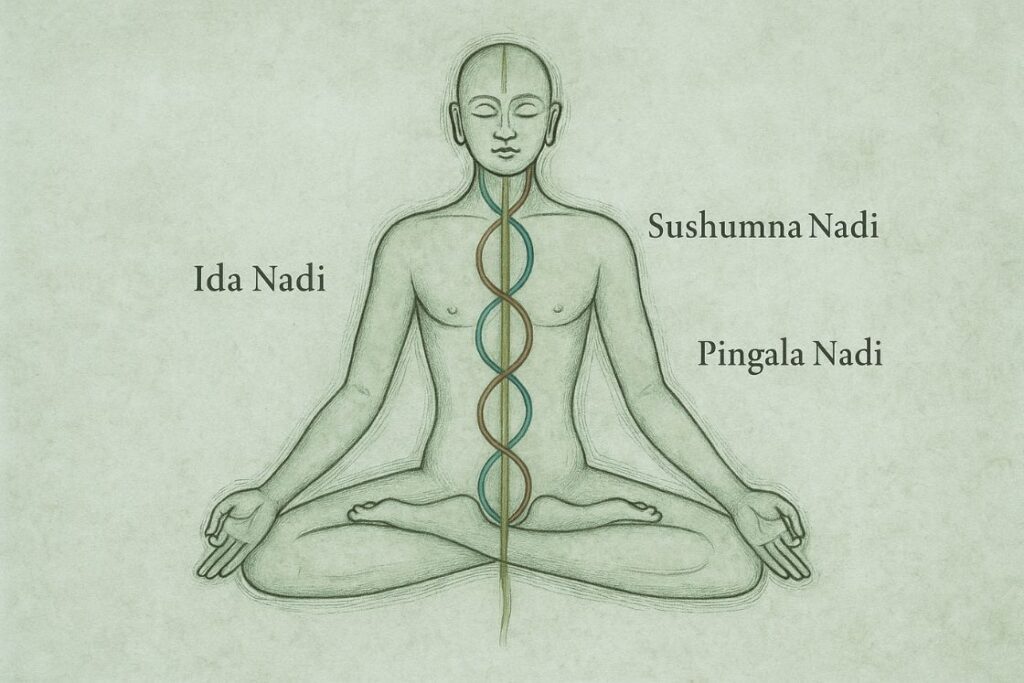
Nadis: energy channels
Yoga describes thousands of fine channels called nadis, which carry prana – the life force-throughout the body. Their purpose is to support physical, mental, and emotional balance.
Three nadis are most important:
1. Ida Nadi
- Runs along the left side of the spine
- Linked with the left nostril
- Associated with calmness, cooling energy and the reflective aspect of the mind
- Supports rest, intuition and emotional ease
2. Pingala Nadi
- Runs along the right side of the spine
- Linked with the right nostril
- Carries warm, active and stimulating energy
- Supports movement, vitality and mental focus
3. Sushumna Nadi
- The central channel within the spine
- Considered the main pathway for spiritual growth
- Kundalini rises through this channel when the system is balanced
When Ida and Pingala come into balance through breath and awareness, Sushumna becomes steady, and the inner energy is able to move upwards without disturbance.
Chakras: the seven energy centers
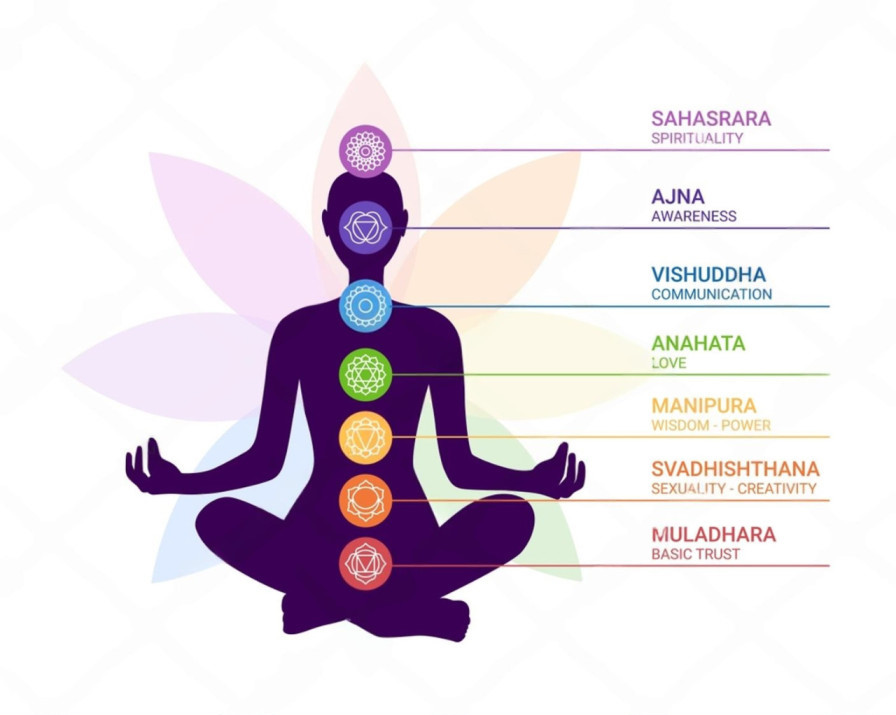
Chakras are points of awareness where nadis meet. Each chakra has a location, emotional quality, and connection to a gland. The following descriptions reflect traditional teachings:
1. Mooladhara – Root Chakra
Mooladhara is the root place of Kundalini energy, where it lies in the dormant state (denoted as a coiled serpent). The exact place of kundalini energy in our body is easy to know. Roughly its dominance is found in the pelvic area.
Kundalini yoga helps in the stimulation of this chakra, which results in the awakening of the dormant serpent energy lies within it. This helps in regulations and an advanced functioning of the excretory system.
2. Swadhisthana – Sacral Chakra
Once Kundalini activates, Swadhisthana is the second place of kundalini passing. It is located two inches above the root chakra. This chakra is said to be blocked due to fear, especially the fear of death.
Kundalini yoga involves the mantra chanting and meditation techniques, which help in unblocking this chakra. However, on balance, it makes a practitioner fearless and creative.
3. Manipura – Navel Chakra
Manipura comes at third place as kundalini ascends along the spine.
Kundalini yoga rectifies the hurdles causing its blockage & fills an individual with enthusiasm, self-confidence, wisdom, and spiritual highness.
4. Anahata – Heart Chakra
Anahata chakra is located near the heart, along the line of the spine. This chakra is represented by the lotus flower with 12 petals.
When kundalini passes through the heart chakra, it provokes the qualities of love, kindness, compassion, peace, purity, understanding, empathy, bliss, forgiveness, peace, unity, harmony, etc.
5. Vishuddhi – Throat Chakra
Vishuddhi chakra is located at the throat position in the vicinity of the spine. It is believed that the blockage of this chakra brings death and decay to an individual.
However, practising kundalini yoga under the guidance of a trained master can do wonder to a practitioner. Unblocking or opening of throat chakra transforms the negative experience into wisdom and learning. It also corrects the feeling of guilt, if once opened.
6. Ajna – Third Eye Chakra
Ajna is located in the center of the forehead and between the eyebrows. It signifies the subconscious mind.
Kundalini yoga with the help of breathing techniques, trataka, sambhavi mudra, etc helps in opening of this chakra. This further connects people to their intuition, revelation past and future scenarios.
7. Sahasrara – Crown Chakra
This chakra is located at the top of the head.
Kundalini yoga helps in opening or unblocking this final chakra to generate pure consciousness or bliss in the individual. However, the accomplishment of this chakra induces the state of Nirvikalpa samadhi.
How kundalini yoga works
Kundalini Yoga prepares the system gradually so that the inner energy can move without strain. The process can be understood in three steps.
1. Clearing energy blocks
Long sitting hours, stress, and irregular breathing can create tension in the spine and pelvic area. The practice of Sat Kriya, found in many classes, helps release this tension. It uses rhythmic movement and the sound “Sat Nam” to support the natural flow of prana.
As posture improves and the breath becomes steady, the energy channels begin to clear.
2. Stimulating the energy
Next, practices gently stimulate the inner energy. Asanas that lengthen the spine create space. Bandhas– Moola, Uddiyana, and Jalandhara—act as internal locks that guide prana upward.
These are not performed forcefully. They are applied with awareness so the inner energy and prana can interact gradually.
3. Directing energy upward
Breathwork plays a key role here. Long deep breathing, alternate nostril breathing, and breath of fire help balance the nadis and bring attention to each chakra.
Meditation completes the process. When the mind becomes still after breath and movement, the energy rises naturally through the central channel.
The bihar school of yoga approach (traditional kundalini path)
The Bihar School of Yoga presents Kundalini Yoga as a complete and traditional system. Its teachings come from Tantra and classical yoga texts, where the journey of awakening is slow, steady and supported by purification of the whole being. In this approach, awakening is not seen as a sudden event but as a natural result of preparing the body, breath and mind.
- Foundation in Tantra
The Bihar tradition bases its teachings on Tantra, where the human being is viewed as a combination of physical structure, subtle channels, mental patterns and spiritual potential.
Tantra explains the symbolic form of Kundalini, the chakras, the nadis and the link between prana and the mind. It shows that prana does not move freely when the mind is restless, and the mind cannot settle when prana is uneven. This understanding forms the base of all Kundalini practices in the Bihar system.
- Preparatory practices
Before working with Kundalini, the Bihar tradition emphasises shuddhi, or purification. This includes several preparatory practices:
- Shatkarmas: cleansing techniques such as neti, dhauti and kapalbhati to clear blockages.
- Asana: steady postures that open the spine and strengthen the nervous system.
- Pranayama: breath practices that balance Ida and Pingala.
- Yoga Nidra: deep relaxation to release mental tension and emotional pressure.
- Mouna: periods of silence to calm the inner dialogue.
These practices prepare the body and mind so that they can hold higher energy without strain.
- Kriya yoga (satyananda system)
A central part of the Bihar School method is the Kriya Yoga taught by Swami Satyananda Saraswati. This system contains twenty kriyas arranged in a specific order. Each kriya combines:
- steady breath
- visualisation
- chakra awareness
- movement or internal focus
The kriyas work layer by layer. They remove tension, activate subtle centres and guide the energy gently upward. Because the practices are arranged in a sequence, students progress gradually and safely.
- Mantra and nada yoga
Sound plays an important role in the Bihar system. Practices include:
- Ajapa Japa, the natural repetition of a mantra with the breath
- Seed mantras associated with different chakras
- Inner sound meditation, where attention rests on subtle vibrations within the body
These practices keep the mind steady and help prana flow smoothly through the central channel.
- Mudras and bandhas
The Bihar tradition teaches several classical mudras and bandhas that support the rise of inner energy:
- Moola Bandha to draw awareness to the base
- Uddiyana Bandha to lift prana upward
- Jalandhara Bandha to steady the upper channel
- Maha Mudra, Maha Bandha, Maha Vedha, and other traditional techniques
These practices refine the flow of prana and strengthen the energetic structure needed for awakening.
Why bihar yoga emphasises gradual awakening
The Bihar tradition teaches that the body and mind must be purified before Kundalini rises. Sudden or forced awakening can disturb the system. A gradual approach protects the practitioner, builds stability and ensures that the rising energy brings clarity rather than imbalance.
By working step by step with breath, posture, cleansing and awareness, the Bihar School of Yoga provides a safe and complete path for students who wish to explore Kundalini in a traditional way.
Join Our 40-Day Live Tantra-Based Kundalini Yoga Course
Kundalini awakening and the chakras: what to expect
Kundalini awakening is described in yogic tradition as a gradual unfolding of awareness. As the inner energy begins to move upward through the central channel, it touches each chakra and refines its qualities. This process is gentle when the body, breath and mind are prepared, and it may feel different for every student.
- Traditional explanation
According to the classical teachings, Kundalini rests at the base of the spine and travels through the chakras as the system becomes clear and steady. Each chakra represents a level of understanding and awareness. When the energy reaches a chakra, it is said to bring lightness, clarity and a sense of inner growth in that area.
These descriptions are symbolic as well as practical. They help students understand how inner transformation can unfold. The movement of Kundalini is not shown as a forceful rise but as a natural response to a purified and balanced system.
- Physical, emotional and mental shifts
Students sometimes notice subtle changes when they practise regularly:
- Physical: better posture, smoother breath, a sense of lightness along the spine
- Emotional: more stability, less reactivity, easier release of old tensions
- Mental: clear thinking, stronger focus, deeper concentration
These shifts may appear slowly over time. They are usually the result of steadiness in breathwork, meditation, and lifestyle changes, not sudden or dramatic events.
Some traditions describe warm sensations, gentle vibrations or increased sensitivity in certain areas of the body. These can happen for some people, but they are not required for progress. A calm mind and a balanced nervous system are the strongest signs of stable growth.
Why experiences vary
Every practitioner has a different physical structure, emotional background and level of preparation. This is why experiences of Kundalini are never identical. Some students feel subtle changes early, while others notice shifts only after months or years of practice.
The tradition explains that the speed and nature of awakening depend on:
- purity of breath and prana
- steadiness of mind
- strength of the nervous system
- guidance from the teacher
- personal lifestyle and discipline
Because these factors differ for everyone, the journey also differs.
Safety Message
Kundalini awakening should not be forced through intense breathwork or long sittings without guidance. Sudden attempts to stimulate this energy can strain the nervous system or create emotional imbalance. The safest path is slow, supported and grounded in regular practice.
No guarantee of dramatic sensations
Not every practitioner will feel heat, vibration or strong sensations. Traditional teachers remind us that these signs are not proofs of awakening. Quiet inner stability, clarity in awareness and balanced emotions are more reliable markers of progress.
Kundalini Yoga is not about chasing dramatic experiences. It is about steady refinement, inner balance and the growth of awareness in a gentle and natural way.
Kundalini yoga vs other styles of yoga
Kundalini Yoga stands apart because it works directly with the subtle energy system through breath, sound, inner awareness and classical yogic methods, while other styles focus mainly on posture, movement, strength or alignment.
| Yoga Style | Main Focus | Key Practices | How It Differs from Kundalini Yoga |
|---|---|---|---|
| Hatha Yoga | Steady postures and breath control | Asanas, pranayama, cleansing practices | Builds physical strength and balance first. Kundalini adds chakras, nadis, mantra and inner energy work. |
| Ashtanga Yoga | Discipline, strength, fixed sequences | Set series of poses, ujjayi breath, vinyasa | Strong and athletic. More physical intensity, less focus on subtle energy. |
| Vinyasa Yoga | Flowing movement with breath | Continuous transitions, creative sequences | Energetic and fluid. Kundalini uses slower, inward practices rather than dynamic flow. |
| Iyengar Yoga | Alignment, precision, therapeutic support | Props, detailed instruction, long holds | Focuses on structural balance, not energy awakening. Does not emphasise chakras or bandhas. |
| Modern Kundalini Yoga (Yogi Bhajan Style) | Quick energetic shift and group practice | Kriyas, breath of fire, mantra chanting | Faster pace. Designed for immediate vitality. Traditional Kundalini (Bihar) is slower and more gradual. |
| Bihar School of Yoga (Traditional) | Step-by-step inner purification | Shatkarmas, pranayama, mudras, bandhas, classical kriyas | Slow and methodical. Aims for safe inner awakening without sudden stimulation. |
Benefits of kundalini yoga
Kundalini Yoga is a gradual journey from the base of the spine toward higher awareness. As the inner energy becomes clearer and more active, it supports the whole being-physically, mentally, emotionally, and spiritually. The benefits unfold over time as breath, posture, sound, and meditation work together.
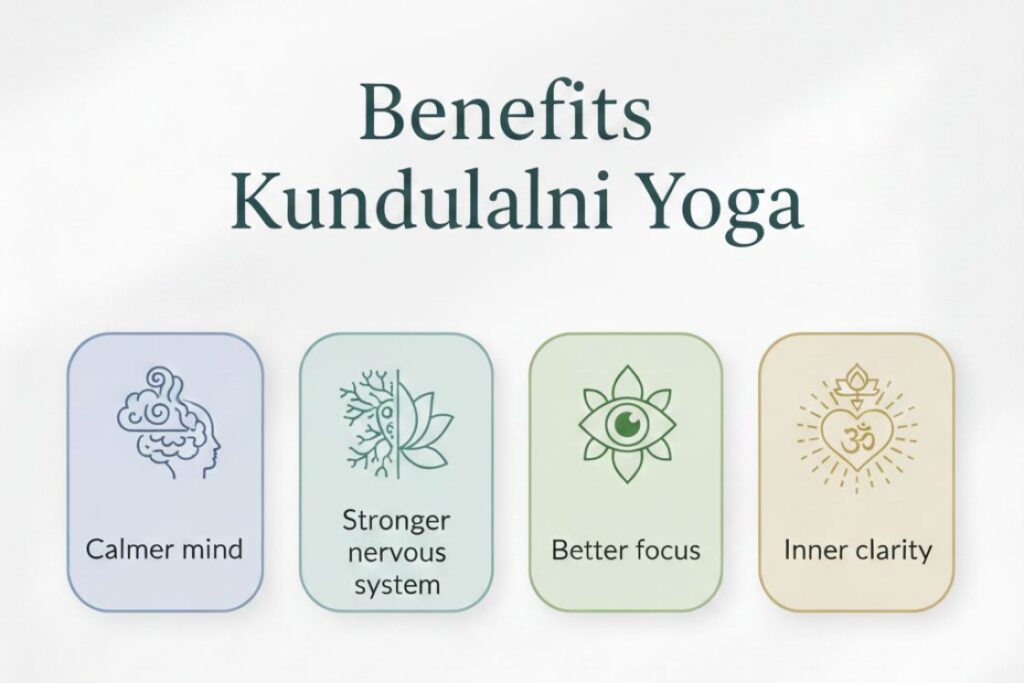
1. Calms the fluctuating mind
Breathwork and meditation are core parts of Kundalini Yoga, and they work together to quiet the mind.
Steady breathing increases the flow of prana and helps the mind settle, while meditation guides this calmness into focused awareness. Many students feel less restlessness and more emotional ease when these two practices are combined.
Modern research also supports this. A clinical study found that people who practised Kundalini Yoga showed reduced anxiety and emotional stress, and another study observed a drop in cortisol levels, the hormone linked with tension. These findings match what the tradition has always said: slow breath and steady attention naturally calm the inner disturbances.
2. Strengthens the nervous system
A steady nervous system helps us respond to life with clarity rather than reaction.
Kundalini practices—such as rhythmic breathing, gentle kriyas and the use of bandhas train the body to stay centred even when life becomes demanding. With regular practice, students often notice they feel more stable, less overwhelmed and better able to handle stress.
Scientific studies reflect this idea as well. Research on yoga and breathwork shows that these practices support nervous system balance and reduce the body’s stress responses. This explains why many practitioners feel stronger from within and less shaken by everyday challenges.
3. Improves concentration and focus
Kundalini Yoga brings attention to the spine and the higher chakras, especially the heart and crown centres.
In traditional teachings, these centres are linked with insight, clarity and inner guidance. As the breath becomes deep and steady, the mind also becomes steady, and this naturally improves concentration. Many students find they can stay present for longer, think more clearly and make decisions with greater ease.
Modern studies support this experience. Research on Kundalini practices has shown improvements in memory, attention and overall cognitive function, especially in adults dealing with stress or age-related changes. These findings reflect what yogic wisdom has always taught: when breath and awareness move together, the mind becomes clear and focused.
4. Encourages a shift from outer pressure to inner clarity
Kundalini Yoga helps reduce the constant pull of outer demands—status, achievement or the need for approval.
As awareness rises through steady breath and mindful movement, students begin to feel more anchored within themselves. The mind becomes less driven by comparison or restlessness and more guided by inner clarity. This shift often brings a sense of freedom, purpose and connection to one’s true nature.
Research on Kundalini and meditative yoga practices supports this inner change. Studies show improvements in emotional balance, self-compassion and overall well-being among regular practitioners. These findings reflect what yogic tradition has long described: when the inner energy becomes steady, the mind naturally turns inward and life is guided more by clarity than pressure.
Kundalini Yoga supports calmness, mental focus, emotional balance, and a deeper sense of purpose by bringing breath, awareness, and inner energy into harmony.
Essential precautions
Kundalini Yoga is a deep and powerful path, and it should be approached with care. The practices are safest and most effective when followed step by step. These guidelines help ensure that the body, breath and mind remain balanced throughout the journey.
- Start Slowly: Beginners should move at a gentle pace. Short sessions with simple breathwork and easy movements are enough in the beginning. This allows the body to adapt and prevents strain on the spine and nervous system.
- Avoid Forceful Breathwork: Strong or rapid breathing techniques should not be done without preparation. Forcing the breath can disturb the balance of prana and create tension instead of clarity. Practise only the methods that suit your level and always breathe comfortably.
- Learn From Qualified Teachers: Guidance is important, especially for practices involving mudras, bandhas or advanced kriyas. A trained teacher can help correct posture, adjust the breath and make sure the practice is safe. They can also help you understand the signs of over-effort or imbalance.
- Take Medical Advice if Needed: If you have a medical condition, take regular medication, or experience dizziness, anxiety or strong emotional swings, consult a healthcare professional before starting intense practices. Yoga supports health, but it should not replace medical guidance.
- Respect the Energy and the Process: Kundalini Yoga is not about forcing results. Respect the pace of your body and mind. When the system is ready, inner changes happen naturally. Trust steady practice, patience and awareness. A calm and humble approach brings deeper and more stable progress.
Conclusion
Kundalini Yoga offers a complete path for understanding the body, breath, mind and the subtle energy that supports them. It shows that true transformation begins within, through steady preparation and balanced awareness. The rise of Kundalini is not a display of power or dramatic experience. It is a quiet unfolding of clarity, sensitivity and inner strength.
Awakening happens naturally when the system is ready. The purpose is not to seek extraordinary sensations but to develop a stable and open state of mind. This journey teaches patience, discipline and trust in one’s own inner process.
Humility is the foundation of this path. Guidance from experienced teachers, along with simple and regular practice, helps the energy move in a safe and grounded way. When approached with respect, Kundalini Yoga leads to a deeper understanding of oneself and supports a way of living that is calm, aware and connected.
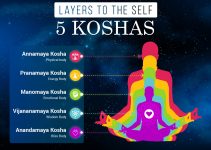




Thanks for including real user stories — very relatable.
very informative articles or reviews at this time.
A heartfelt piece. The mix of modern insights and the Bihar tradition felt very aligned. Really appreciated this.
Ajna is not Throat Chakra, Its Third eye. Above illustration is wrong. Check pic please
What is the significance of thumb to first two fjngers,? Doing it spontaneously and feel intense current.
Can you please explain a little more your query? Then I’ll try to answer it.
Thank you. Simple yet effective explanation.
Thank you Rishab.